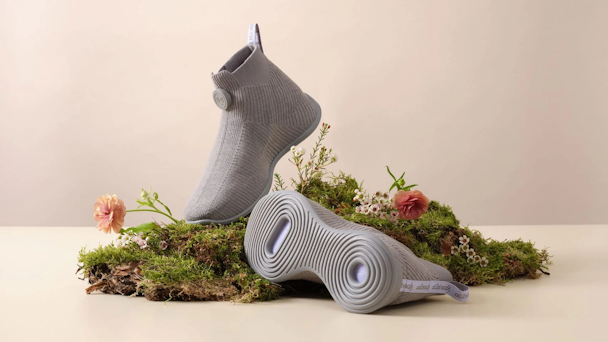Allbirds claims world’s first carbon-neutral shoe and wants to share secrets with rivals
We sit down with the sustainable footwear company’s co-founder Tim Brown and sustainability manager Aileen Lerch to hear why they’re giving other sneaker brands access to its playbook.

Allbirds launched its net-zero shoe last week at the Global Fashion Summit in Copenhagen / Allbirds
Last week, at the Global Fashion Summit in Copenhagen, Allbirds launched its highly anticipated Moonshot – the world’s first carbon-neutral shoe achieved without offsetting. Now, it is urging the rest of the fashion industry to follow suit by giving away its toolkit.
At its core, Allbirds is a brand founded on sustainability, but increasingly it has come to realize sustainability means a hundred different things to a hundred different people says co-founder Tim Brown. “From biodiversity to water quality to animal welfare, the list goes on and it can lead to a lot of competing incentives and complications, leaving you feeling like you’d be better off just staying in bed.”
Advertisement
Achieving net zero without offsetting
In a bid to start somewhere, understanding the fundamentals of the brand’s carbon footprint has allowed the Allbirds team to focus with precision on the process of decarbonizing across the entire supply chain, says Brown. “That has been instrumental in the way that we innovate around products.”
This has been done through long-term partnerships, he explains, such as its relationship with New Zealand Merino, a growing network of 500 farms in New Zealand “that represent 15% of New Zealand’s agricultural land mass on a regenerative agriculture pilot program,” spearheaded by Allbirds’ senior manager of sustainability Aileen Lerch. Brown calls this “Moonshot’s foundation”.
The culmination of years of work, Moonshot boasts a landmark carbon footprint of net 0.0 kg CO2e across the five stages of the product’s lifecycle: materials, manufacturing, transportation, use and end of life.
“We’ve called in the Moonshot because we wanted to make sure people know it’s very hard to do, but it’s also achievable,” says Brown.
From the carbon-negative regenerative wool that forms the shoe’s exterior to the molded components including eyelets and logos made with methane-capture plastic, the shoes will be vacuum-packed in sugarcane-based polyethylene – a carbon-neutral material – reducing weight and space required for transportation, which happens via biofuel-powered shipping and electric vehicle trucking. “There’s an extraordinary amount of detail gone into making this object.”
Advertisement
The need for transparency
But in the face of increased scrutiny on green claims across Europe, particularly around net zero strategies and the lifecycle of products, sustainability boss Lerch says that what makes Allbirds feel comfortable stepping out and waving its carbon-neutral banner is that it has “humility”.
“We don’t have all the answers and we’re ready to keep learning and trying, knowing we don’t have the solution to everything,” she says, adding that Allbirds has provided the utmost levels of transparency through the open-source availability of its playbook.
Suggested newsletters for you
As well as transparency there is the third-party verification of all the elements outlined in the open-source, although Lerch concedes that it’s “impossible to have every single thing independently verified“.
“In all the core elements, we’ve really gone to town though. In a tense environment, it’s these things that make us feel able to stick our necks out.”
Looking to the future, Brown and Lerch tell The Drum that they’re excited to see more rigorous standards and frameworks, not just for brands to measure their carbon emissions but also incentives for regenerative practices and biodiversity schemes that see them give back to nature. “This is something that’s been ingrained for us since day one, because of our focus on natural materials,” says Lerch.
The biodiversity question
“But there are trade-offs,” admits Brown. “We need to think about carbon the way we do calories in food – it’s not the only answer to a healthy diet and you need to consider all the other inputs. In the pursuit of lower carbon, regenerative wool, you could do things that divert the natural environment, so we are also taking a monocultural approach.”
Ultimately, Brown says: “A product can’t be considered great today unless it’s deeply anchored in the principles of sustainability.” The Moonshot’s focus is on reducing carbon, but in the future Allbirds would like to see this focus spread across the sectors, he says. “Part of the answer is we need to consume less, but it’s not the whole answer. We also need to re-engineer and rethink the products we use every day through the lens of nature.”
We also need to ensure the conversation around sustainability “doesn’t become for an elite few” but becomes about better products, better experiences and economic growth for all, he concludes. That starts by making a product’s carbon footprint as easy to view as the calories in a chocolate bar.

